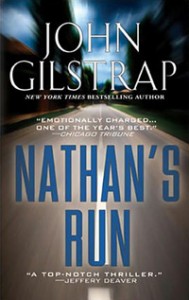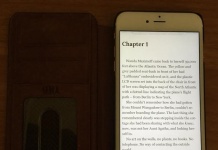
I’m late coming to John Gilstrap, which is too bad. He’s an excellent thriller writer. I burned through a couple of his Johnathan Graves books, and just finished Nathan’s Run, which was his first published novel. Until I read the Afterward, I hadn’t realized it has been a Banned Book, which made a review this week well-timed.
The premise is that a 12-year old boy, Nathan Bailey, escapes from a juvenile detention center, killing a guard during the escape. What’s interesting is that there’s never any doubt about the murder. We know Nathan killed the guard. What we learn throughout the book is why he killed him. As you can probably imagine, the truth is more complicated than the law enforcement officials and prosecutor would like to believe.
Gilstrap does an excellent job at getting into the head of a 12-year old boy. He and I had a brief exchange about that on Facebook, and he said it’s because his wife tells him he’s never matured past 12. I rebutted by saying that’s true of most men. 🙂
Nathan’s not the only great character. Warren Michaels, who leads the law enforcement effort has a back story that makes the hunt more complicated for him. There’s J. Daniel Petrelli, the prosecutor you’ll love to hate. And then there’s Denise “the Bitch” Carpenter, the radio personality who talks to Nathan several times on her radio show. I was prepared to dislike her at first, but she ended up my favorite character, after Nathan. I thought I detected a hint of Venice-to-come in her character. Venice is the sassy computer specialist from the Graves books.
There are some interesting things about this book beyond the plot. In the afterward, Gilstrap says he went to some effort to not be classified as Young Adult (because of the age of the protagonist). Keep in mind that this was published just before Harry Potter launched YA as a genre adults would want to read. So he added a fair amount of harsh language to keep it firmly in the adult category.

And what happened? It won an Alex Award from the American Library Association, classifying it as one of the best adult-market books for young adult readers. Schools bought it. Kids took it home. Adults saw the language, and at one point Nathan’s Runwas among the 100 most banned books in America. Oops. The edition I read was revised to remove most of the language. Gilstrap says he left one F-bomb in for a reason. I’ll attest that it was entirely appropriate.
This book was also written before the Columbine shooting, and I wonder if it would have had the same response if it had been published just a few years later. As the Nathan story plays out in the media, a significant percentage of the public ends up on Nathan’s side. I’m not sure that would happen today, as we’re more aware of youth violence. The book does feel like it happened in a simpler time. It’s still a good read, and I recommend it highly, but I think readers today may take longer to warm up to Nathan. I’d be curious to hear thoughts from others who’ve read it.
It’s not a perfect book. It lacks some of the polish of Gilstrap’s later books. I noticed several (to me) jarring point of view changes early on, but it’s well worth reading. I appreciated reading a story about a young protagonist that was treated as an adult book and wasn’t written for the YA audience. I think that choice made it a deeper, more complex book.
Should you let your teen or tween read it? I’d say yes, with qualifiers. There is some graphic description and violence. None is over the top and it’s all appropriate for the subject matter, but I would suggest parents of tweens read it first and judge for themselves.
Nathan’s Run is a solid 4 e-reader book.

Oh, and watch this space. Next month, I’ll be publishing an interview with John Gilstrap, as soon as he finishes, according to him, a “crushing book deadline.”


































I have not read this novel yet, but plan on doing so very soon. Referring to Juli’s review, I appreciate her disclaimer of language and violence, but I’d have to say that both have become a way of life for our youngsters. Video games provide the blood guts and gore to desensitize them to violence, language, and decency, and the programming infuses them with the extra lives they believe they have available in real life.
Violence in a book is one thing, violence in large video quantities is quite another, and for my money–I prefer the kid read a book over playing a violent video game any day.
But that’s just me.
DB Corey
@DB, I don’t disagree with you. However, I know several parents who do try to limit their tween’s exposure to violence, and they would appreciate knowing what’s there so they can make an informed decision. Other parents would like to be prepared for questions.
Although it’s not described in detail, there is a reference to a character being raped with a broom handle. It’s the sort of thing I would have liked to have been prepared for in advance.
Ah yes …
I see your point.
😉
DB